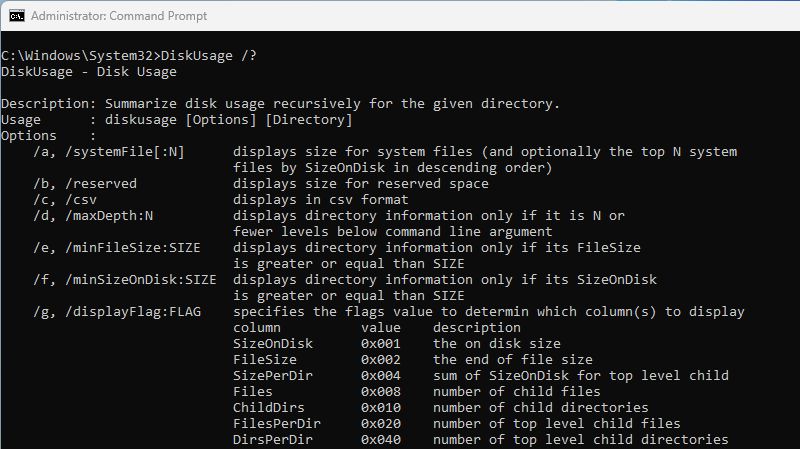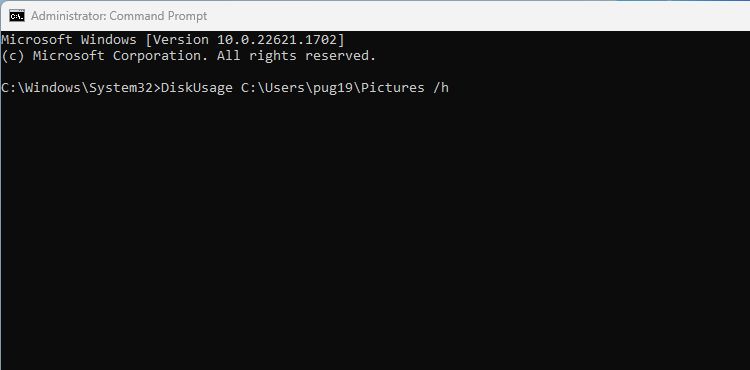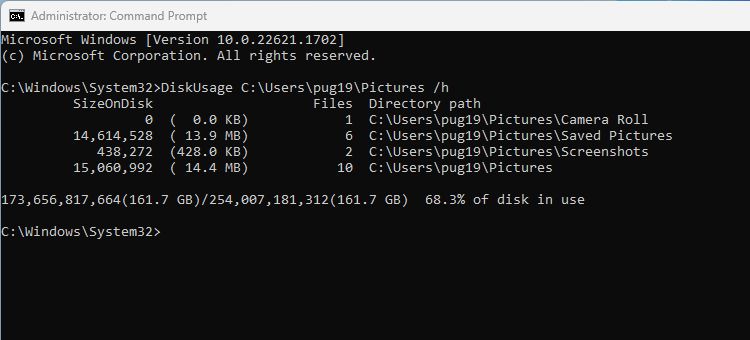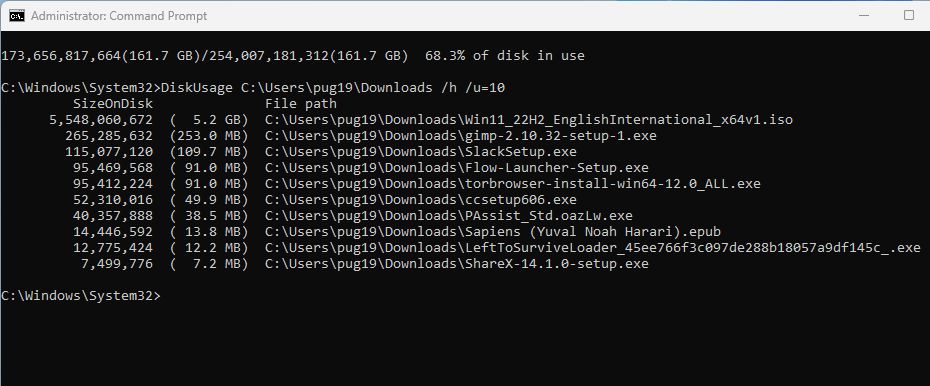
Enhancing Your Knowledge of Storage Management Using Windows DiskUsage Commands

Enhancing Your Knowledge of Storage Management Using Windows DiskUsage Commands
The DiskUsage.exe tool can be used to analyze the contents of any drive or folder on Windows 11. DiskUsage is accessed from the command line and includes many options for filtering and refining the file data that can be output. In certain situations, this can make it far more useful than GUI tools like Storage Sense.
Here’s how to start using DiskUsage.exe to view and analyze how the space in your drives is being used.
Disclaimer: This post includes affiliate links
If you click on a link and make a purchase, I may receive a commission at no extra cost to you.
View Disk Usage of Any Drive or Folder
The simplest way to use the DiskUsage command line tool is to get an overview of how space is currently used in almost a drive or folder. We have used the tool on Windows 11, but it is also available on Windows 10.
- Run the Command Prompt as an admin. If you need help, check out how to run the Command Prompt as an administrator .
- In Command Prompt type DiskUsage followed by the path to the drive or folder you want to analyze.
- For example, to view the disk usage of the Pictures folder, type: DiskUsage C:\Users\UserName\Pictures, and press Enter.

- To see the SizeOnDisk number in a human-readable format, e.g. KB, MB, or GB, add /h to the end of the command.
- In our example, this looks like DiskUsage C:\Users\UserName\Pictures /h.

You can use DiskUsage to analyze any folder in the same way. You can even check internal and external drives, including the C: drive. Bear in mind that analyzing a drive such as C: will spew out a huge list of files and folders in DiskUsage.
If using DiskUsage.exe seems too complicated, you can easily view how disk space is being used with Storage Sense .
List All Files Larger Than a Specified Size
You can refine the data displayed in DiskUsage based on file size. So if, for example, you only want to include files over 500MB, you can set it to ignore smaller files.
- To only include files above a specific size, you need to add the minFileSize option to the command.
- As an example: DiskUsage /minFileSize=6553600 C:\Users\UseName\Downloads /h.
- This will only look for files in Downloads larger than 50MB and then display the disk space those files occupy in that location.
- The file size number must be entered in bytes, so you might have to convert MB to Byte using an online conversion tool.
For a more detailed view of large files, including file name as well as size, you can use the /u command modifier. This allows you to list a defined number of the largest files in the drive or folder.
- To do this type: DiskUsage C:\Users\UserName\Downloads /h /u=15.
- The 15 largest files in the Downloads folder will now be listed in Command Prompt.

- You can replace the number with any other you want to use. For example, to see the top 5 files taking up space, use /u=5.
- Make sure to include the /h option so that the output is in a format that’s easy to read.
After identifying what is taking up the most space, you can use any one of these methods to delete large files .
Additional DiskUsage Command Options
The DiskUsage tool contains several other useful options that you can use to filter the output. You can filter by filename, display reserved space, or the largest directories within the folder.
For example, to filter by filename add /n=installer to the end of the command to display only files that contain the word installer.
You can see a complete list of the options by typing DiskUsage /? and pressing Enter.

Analyze Drive Space With DiskUsage
Many of the available command line tools are extremely useful for maintaining and managing your Windows PC. And as this guide shows, DiskUsage.exe is a powerful alternative to graphical UI tools such as Storage Sense if you want to really dig down into how your drive space is being used.
Here’s how to start using DiskUsage.exe to view and analyze how the space in your drives is being used.
Also read:
- [New] Dissecting the Benefits of Using SNS HDR over Others for 2024
- [New] Navigating Beginner's Vlogging Landscape for 2024
- [New] Starter’s Guide to Optimal GoPro Accessories List for 2024
- 3 Ways to Change Location on Facebook Marketplace for Honor 100 | Dr.fone
- Clearing Windows DNS Cache via Steam Settings
- Decoding the Process Behind GoPro Burst Recordings for 2024
- Easy Audio Recording: The Windows 11 Handbook
- Enhance Archived Media: MadVR for Windows Enthusiasts
- Guide to Turn Off Microsoft's Voice Assistant
- How to Enable, Disable, and Change Safari Location on Apple iPhone 14 Pro Max | Dr.fone
- In 2024, Action Replay Compare GoPro's Hero5 Black & Session
- In 2024, Forgotten The Voicemail Password Of Poco C55? Try These Fixes
- Latency Logic: How to Quickly Examine Ethernet Performance
- Make Windows 11 Work Better with a Simple Update
- Quick Fixes for Lost Steam Connections on PC
- Strategies to Correct Windows ALT Key Problems
- Streamlining Temporary File Extraction in Windows OS
- Unified Imagery The Ultimate Blend Strategy
- Utilizing NAS on Smartphones and Tablets
- Title: Enhancing Your Knowledge of Storage Management Using Windows DiskUsage Commands
- Author: Richard
- Created at : 2024-10-30 19:34:30
- Updated at : 2024-11-01 18:49:55
- Link: https://win11-tips.techidaily.com/enhancing-your-knowledge-of-storage-management-using-windows-diskusage-commands/
- License: This work is licensed under CC BY-NC-SA 4.0.


